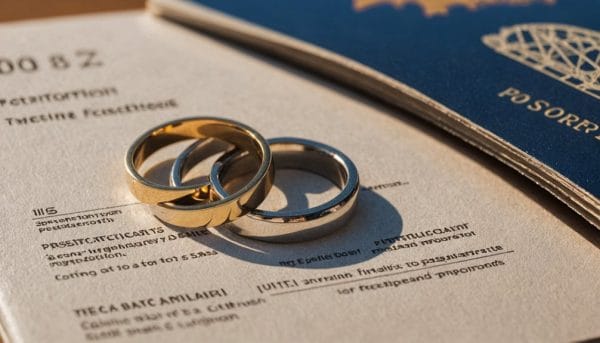Estate planning is about more than wills and inheritance. A binding financial agreement (BFA) can act as a planning [...]
Are you getting a divorce?
Make sure you get the best outcome possible, for you and your families’ future.
More than 100+ years of combined lawyer experience.
If you’re looking to get an international divorce in Australia, there are certain steps you’ll need to follow. First, you must have been separated for at least 12 months, and you’ll also need to provide proper documentation of your overseas marriage. You can apply through the Federal Circuit and Family Court of Australia, but you must hold either Australian citizenship or residency. Generally, foreign divorces are recognised if one party had a legitimate connection to the country where the divorce occurred. Ensure you have English translations of all your documents and that your paperwork is properly authenticated. While Australia’s no-fault divorce system makes things a bit easier, international cases can be tricky with jurisdiction and custody issues needing careful consideration. Think of it like trying to solve a puzzle where each piece represents a different legal aspect. Keep in mind that paying attention to detail is crucial in these situations.
How Does International Divorce Work in Australia?
An international divorce in Australia applies when you’re seeking to end a marriage that involves foreign elements, such as overseas marriages or spouses living abroad.
You can file for divorce in Australian courts if you or your spouse meet citizenship, domicile, or 12-month residency requirements under the Family Law Act 1975.
While Australia’s family law system simplifies the divorce process by recognising overseas marriages and divorces, you’ll need to address property division and child custody arrangements through separate legal proceedings, especially when dealing with international assets or cross-border parenting matters.
What is an International Divorce?
International divorce emerges when spouses live in different countries or need to dissolve a marriage across international borders.
When you’re seeking a divorce obtained from an overseas jurisdiction, you’ll need to guarantee your marriage is recognised in Australia.
The legal process follows Australia’s no-fault divorce system, making it simpler than many other countries.
You’ll need to take into account applying to the court with proper documentation and jurisdictional requirements.
How to Apply for a Divorce in Australia?
When seeking a divorce in Australia with international elements, you’ll need to meet specific eligibility requirements and follow a structured application process.
To apply for divorce, verify you’ve been separated for 12 months and either you or your spouse is an Australian resident or citizen.
If you married overseas, submit your translated marriage certificate to the Australian court.
You’ll need to have divorce documents properly served to your spouse 42 days before the hearing.
Understanding the Role of Family Law in International Cases
The Family Law Act 1975 provides the legal framework for handling international divorces in Australia.
You’ll need either spouse to be an Australian citizen, domiciled, or a resident for 12 months before filing.
For divorce obtained from an overseas jurisdiction, the Family Court of Australia can recognise it if it meets legal requirements.
Understanding the legal process is essential, especially for international custody disputes affecting married couples.
Is a Foreign Divorce Recognised in Australia?
Your foreign divorce will generally be recognised in Australia if either party was a resident or citizen of the country where the divorce took place and the divorce meets Australian legal standards.
You’ll need to ensure your divorce documents are translated into English and comply with both the local jurisdiction’s requirements and Australian public policy.
To have your overseas divorce officially recognised, you’ll need to provide evidence of your connection to the foreign jurisdiction and submit properly authenticated documentation to Australian authorities.
When is a Divorce Valid in Australia?
Australia’s recognition of foreign divorces follows clear guidelines under the Family Law Act 1975.
Your divorce under Australian law is valid when either you or your spouse is an Australian citizen or has lived here for 12 months.
For divorces obtained from an overseas jurisdiction, Australian courts require properly translated documents with supporting affidavits.
You must also guarantee the divorce complied with that country’s local laws.
How Does Jurisdiction Affect Recognition?
Regarding foreign divorces, jurisdictional requirements play a crucial role in their recognition within Australia’s legal system.
If you’re living in Australia and seeking a divorce obtained from an overseas jurisdiction, you’ll need to understand that Australia recognises these divorces when:
- The divorce complies with the laws of that country
- Proper jurisdictional connections exist
- The validity of a foreign divorce meets Australian standards
- The divorce doesn’t violate Australian public policy
Steps to Ensure Your Divorce is Recognised in Australia
Getting a foreign divorce recognised in Australia follows a clear set of steps that protect your legal interests.
If you’re living overseas and want your divorce order recognised, you must guarantee your marriage is recognised first by providing translated marriage certificates.
Australian courts require proof of citizenship or residency status, and if you get divorced from an overseas jurisdiction, you must serve them the divorce documents properly.
What Happens if You Were Married Overseas?
If you’re married overseas and seeking a divorce in Australia, you’ll need to prove your marriage is valid under both the foreign country’s laws and Australian legal standards.
You must provide your foreign marriage certificate with an English translation to Australian courts as part of your divorce application.
The recognition of your overseas marriage in Australia doesn’t automatically resolve property or parenting matters, which may require separate legal processes, especially when international assets are involved.
Key Considerations for Divorce in Australia if Married Overseas
Australian courts recognise overseas marriages when couples seek divorce, provided the marriage meets specific legal requirements.
If you’re an Australian living overseas or were married abroad, you’ll need to take into account:
- Your marriage must be registered in Australia before you’re able to apply for divorce.
- You must wait 12 months before applying for separation.
- Australia operates under a no-fault divorce system.
- You must properly serve them the divorce documents.
Handling a Foreign Marriage Certificate
The recognition of a foreign marriage certificate plays an essential role in Australian divorce proceedings.
Your certificate must be valid under the laws of the jurisdiction where you married and meet requirements set out in the Family Law Act 1975.
If it’s not in English, you’ll need it translated by a qualified translator with an accompanying affidavit.
A properly translated and validated foreign marriage certificate guarantees smooth processing of your divorce.
The Impact of Being Married in Another Country
Getting married overseas doesn’t affect your ability to divorce in Australia, provided your marriage meets basic legal requirements.
You’ll need to prepare several key elements:
- Copy of your marriage certificate (translated if not in English)
- Proof that at least one party to the marriage meets residency requirements
- Divorce documents at least 42 days before the hearing
- Evidence that law in Australia recognises your marriage’s validity
When working with divorce lawyers, remember that Australia recognises a divorce obtained from an overseas jurisdiction, though you may need separate proceedings for property settlement.
What is the Process to Apply for a Divorce in Australia?
You’ll need to begin your divorce application in Australia by gathering essential documentation, including your marriage certificate and proof that either you or your spouse meets the residency requirements.
The application process requires you to file your paperwork with the Federal Circuit and Family Court of Australia, ensuring you’ve been separated for at least 12 months and can demonstrate your marriage has broken down irretrievably.
If you’re submitting documents from an overseas marriage, you must provide certified translations and an accompanying affidavit, while also ensuring proper service of documents to your spouse at least 42 days before any court hearing.
Steps to Apply for Divorce in Australia
Applying for divorce in Australia follows a structured process that requires meeting specific eligibility criteria and following set timeframes.
You’ll need to provide proof you’ve separated for at least 12 months before you can file for divorce in Australia.
- Submit your application to the Federal Circuit Court
- Serve divorce papers to your spouse (42 days before hearing)
- Allow response time (28 days domestic, 42 days international)
- Attend divorce hearing if required (mandatory with children under 18)
The Importance of the Marriage Certificate
When filing for divorce in Australia, a valid marriage certificate stands as one of the most essential documents you’ll need to provide.
If you’ve obtained your marriage certificate from an overseas jurisdiction, you’ll need to have it translated by a qualified translator.
Should your certificate be lost, you must secure a replacement from the relevant authority to avoid complications in the divorce process.
Understanding the Divorce Application Process
The divorce application process in Australia follows a clear, step-by-step pathway that typically spans several months.
You’ll still be able to apply if you’re a citizen of that country or have lived in Australia for at least 12 months.
- Verify you’ve been apart for at least 12 months
- Complete and submit divorce application forms
- Serve documents to your spouse with 42-day notice
- Attend court hearing (if required with children under 18)
Even if you’ve obtained a divorce from an overseas jurisdiction, it’s recognised unless contrary to public policy.
How Does Child Custody Work in International Divorces?
 Child custody in international divorces falls under Australia’s legal framework, which prioritises the child’s best interests while considering both parents’ circumstances across different countries.
Child custody in international divorces falls under Australia’s legal framework, which prioritises the child’s best interests while considering both parents’ circumstances across different countries.
You’ll need to comply with Australian family law requirements alongside any relevant international agreements, particularly the Hague Convention, which helps protect children from unauthorised removal across borders.
You must carefully consider each country’s custody laws and enforcement mechanisms when crafting parenting arrangements, as these can greatly impact your ability to maintain meaningful relationships with your children post-divorce.
Determining Child Custody Across Different Countries
Maneuvering child custody arrangements in international divorces presents unique challenges that require careful consideration of multiple legal systems and cultural frameworks.
When you want to get divorced across international borders, Australia recognises divorces obtained from overseas jurisdictions, but custody determinations demand specific attention:
- Courts evaluate the child’s best interests according to both Australian and foreign legal standards.
- The Hague Convention protocols protect against international child abduction.
- Your child’s emotional needs and developmental requirements influence jurisdictional decisions.
- Legal representation must navigate overlapping custody laws between countries.
Legal Framework for Child Custody under Australian Law
Under Australian family law, managing child custody in international divorces requires understanding key legal frameworks that protect your children’s interests across borders.
You’ll need to navigate the Family Law Act 1975, which governs custody arrangements regardless of residency.
The Hague Convention provides additional protection if your child’s wrongfully removed internationally.
Australian courts can enforce foreign custody orders that align with local laws.
Why Seek Legal Advice for an International Divorce?
Your family lawyer serves as an essential navigator through the complex maze of international divorce laws, guaranteeing you understand your rights across different jurisdictions and helping you avoid costly mistakes.
Getting legal advice early can protect your interests by identifying the most advantageous jurisdiction for filing your divorce and securing favourable outcomes for property division and child custody arrangements.
A skilled family lawyer will also guarantee all your documentation meets legal requirements in both Australia and relevant foreign jurisdictions, potentially saving you time and money in the long run.
The Role of a Family Lawyer in International Cases
International divorce cases present unique legal challenges that make professional guidance crucial. A specialised family lawyer serves as your navigator through complex jurisdictional requirements and documentation processes.
- Validates overseas marriages and guarantees proper recognition of foreign documents.
- Manages jurisdictional requirements based on residency and citizenship status.
- Handles international asset division and financial settlements.
- Protects your interests in cross-border custody arrangements and child support matters.
Benefits of Seeking Legal Advice Early
Early consultation with a qualified family lawyer sets the foundation for a smoother international divorce process.
You’ll gain clarity on jurisdictional requirements and guarantee you’re filing in the correct court.
Professional guidance helps you understand property division across multiple countries, navigate overseas marriage recognition, and address child custody complexities.
You’ll also receive structured support to manage documentation requirements and prevent potential legal complications.
Final Thoughts
Handling an international divorce in Australia can feel like navigating a labyrinth, but with the right guidance, you’ll find the path much clearer. Australia’s divorce laws are generally straightforward. However, when international elements creep in, things can get a bit tricky, especially with property division and child custody matters. It’s wise to seek professional legal advice to protect your rights and ensure you comply with both Australian and international regulations. Taking informed steps now is like laying a solid foundation for your life after divorce. Remember, this process is your stepping stone to a secure future.






























